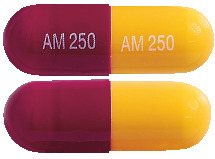1. Why am I using AMOXIL?
AMOXIL contains the active ingredient amoxicillin (as amoxicillin trihydrate). AMOXIL is used to treat a range of infections caused by bacteria.
For more information, see Section 1. Why am I using AMOXIL? in the full CMI.
2. What should I know before I use AMOXIL?
Do not use if you have ever had an allergic reaction to AMOXIL or any of the ingredients listed at the end of the CMI.
Talk to your doctor if you have any other medical conditions, take any other medicines, or are pregnant or plan to become pregnant or are breastfeeding.
For more information, see Section 2. What should I know before I use AMOXIL? in the full CMI.
3. What if I am taking other medicines?
Some medicines may interfere with AMOXIL and affect how it works.
A list of these medicines is in Section 3. What if I am taking other medicines? in the full CMI.
4. How do I use AMOXIL?
- The usual dose of AMOXIL is one dose taken three times a day.
- AMOXIL doses should be spaced evenly throughout the day e.g. every eight hours if taking it three times a day.
- Swallow AMOXIL 250 mg and 500 mg capsules whole with a glass of water. It can be taken with or without food.
- Keep taking AMOXIL until the course is finished or for as long as your doctor tells you.
More instructions can be found in Section 4. How do I use AMOXIL? in the full CMI.
5. What should I know while using AMOXIL?
| Things you should do |
|
| Things you should not do |
|
| Looking after your medicine |
|
For more information, see Section 5. What should I know while using AMOXIL? in the full CMI.
6. Are there any side effects?
Mild side effects of taking AMOXIL include diarrhoea, soreness of the mouth or tongue, or overgrowth of yeast infections (thrush).
Serious side effects include itching; rash; unusual bleeding or bruising; yellowing of the skin or eyes; dark urine or pale stools; difficulty or pain on passing urine; severe diarrhoea; excessive abnormal muscle movements; dizziness or convulsions; or a red rash commonly seen on both sides of buttocks, upper inner thighs, armpits, or neck. Other serious side effects include an allergic reaction. Signs of this include wheezing, swelling of the lips/mouth, difficulty in breathing, hayfever, lumpy rash (hives), or fainting.
For more information, including what to do if you have any side effects, see Section 6. Are there any side effects? in the full CMI.

